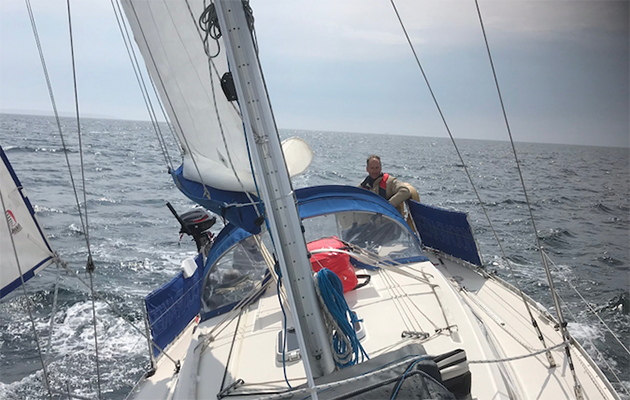A freak wave wreaks havoc on Kass Schmitt and Rupert Holmes' 36ft Zest as they attempt to sail to Lanzarote
Still, it could have been worse… Zest is a 36ft one-off design by Rob Humphreys, built of strip cedar epoxy and launched in 1992.
I bought her in January 2013 with the intention of competing in that year’s Original Single-handed Transatlantic Race (OSTAR), but was unable to complete all the necessary work in time for the start.
Instead, my partner Rupert Holmes and I set about on a programme to prepare me for the 2017 OSTAR.

Kass sailing Zest ahead of the 2017 OSTAR start. Credit: Paul Gibbins
By the end of summer 2015 we had cruised and raced her nearly 12,000 miles, mostly double-handed. We set off from Cowes towards Lanzarote on 13 October.
We were expecting an Atlantic low pressure to arrive around day 5, but the models were not agreeing on its path, so our passage plan provided for a number of contingencies with options to put into ports in Brittany, northern Spain or Portugal if needed.
First impact
By the third day we had made excellent progress, enjoying a fast run down the Channel before reaching south just beyond the Ushant Traffic Separation Scheme.
The wind and seas began to build as the isobars below the persistent high pressure were squeezed. In just 28 knots of breeze we were knocked sideways by a wave.
Continues below…
‘I flew across the boat and landed headfirst’
Jenny Rorrison describes the series of events leading up to her brain operation following a knockdown at sea
‘I saw flames licking out of the companionway’
Rosemary Young recounts fire breaking out on her family cruiser and shares the valuable lessons she learned
‘We hit a lobster pot on a lee shore’
Steve Bowen finds himself in a serious tangle with a lobster pot in UK waters
Rupert was in the cockpit at the time, which was inundated with water, with both his lifejacket and the pulpit-mounted dan-buoy inflating in the green water.
Meanwhile, on my beanbag on the saloon sole, I was awakened by a shower of objects from the port pipe cot.
For safety, we resolved to minimise time spent on deck until conditions improved.

Kass Schmitt is a solo sailor who has long been dreaming of completing the OSTAR. She is the only woman skipper in the 2021 edition
As the wind built into a full easterly gale, we reduced sail, eventually opting to lie a-hull overnight.
In the morning of day 4 we put out a scrap of jib and spent the day comfortably reaching at 6 to 7- and-a-half knots boat speed with wind and wave fine on the port quarter, and a wind vane steering impeccably.
Before it got dark we spent around an hour studying the waves, and had concluded it wasn’t necessary to deploy our drogue.
The sea state was impressive, but orderly, and the wind was forecast to moderate.
Disaster strikes
As we chatted about the sunshine and tradewinds just round the corner, our conversation was interrupted by the roar of a mammoth breaking wave on the port side, further forward than any previous waves.
There followed an even louder bang, accompanied by the sickening sound of tearing wood as we were hit. The lights went out and the boat felt as it if had been thrown sideways.







